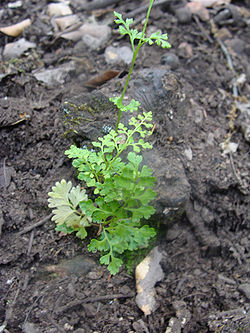| Anogramma | |
|---|---|
 | |
| A. leptophylla | |
| Scientific classification | |
| Kingdom: | Plantae |
| Clade: | Tracheophytes |
| Division: | Polypodiophyta |
| Class: | Polypodiopsida |
| Order: | Polypodiales |
| Family: | Pteridaceae |
| Subfamily: | Pteridoideae |
| Genus: | Anogramma Link [1] |
| Type species | |
| Anogramma leptophylla | |
| Species | |
See text | |
| Synonyms | |
| |
Anogramma is a genus of ferns in the subfamily Pteridoideae of the family Pteridaceae. [2] It contains about ten species, including: [3]
- Anogramma leptophylla (L.) Link (Annual/Jersey fern)
- Anogramma lorentzii (Hieron.) Diels
- Anogramma reichsteinii Fraser-Jenkins